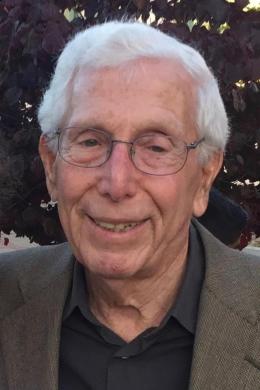J. Peter Winkelstein, longtime SPUR board member, talented architect, mentor, and friend to many, died on March 29 at age 94.
Peter, or Wink — as he was affectionately called by Diane Filippi, former director of the SPUR Urban Center and his long-time business partner — joined the SPUR board in 1998. In his eight years on the board, Peter was co-chair of the Civic Center Task Force, co-chair of the Urban Planning/Policies Committee, chair of the Hospital/Health Care Futures Task Force, and a lead design member on the Doyle Drive Task Force. His work for SPUR continued past his board tenure, as the chair of the new SPUR Urban Center Building Committee.
Peter formed a SPUR task force to address deteriorating conditions in the Civic Center. Here he was clearly the expert. Working with Pei Cobb Freed, his architecture and urban design firm, Simon Martin-Vegue Winkelstein Moris (SMWM), had recently completed the New Main Public Library, which anchored the southeast corner of the Civic Center. In addition to many other civic projects, SMWM had already completed a brilliant master plan for the San Francisco Civic Center, which aimed to both revive the historic grandeur of the space and make it functional for the next century. Peter brought the heft of SPUR into the public conversation to protect and improve this important civic space.
The 1991–1992 national recession hit San Francisco hard, interrupting the regular cadence of development through 1994. It came at the worst possible time for the city, which was still suffering from billions of dollars of damage from the 1989 Loma Prieta earthquake. The voters passed a landmark bond measure to repair public buildings, and Peter led SPUR’s planning and urban design efforts to assure their overall contribution to the public realm as well as their seismic safety. The Palace of the Legion of Honor was the first to be completed, in 1995. The New Main Public Library opened in 1996. The City Hall remodel was completed in 1997. Many others were to follow. During these years, Peter was a major player in diverse SPUR planning and design efforts, including the Union Square design competition and rebuilding, waterfront urban design, the new DeYoung Museum and concourse garage design, and Yerba Buena Center and Moscone Center expansion, as well as the designs of Westfield San Francisco Centre, the Ferry Building and plaza, Market Street, Mission Bay, the Transbay neighborhood, and Rincon Hill. Peter helped determine SPUR’s recommendations on many other programmatic studies, as well, including the functioning of San Francisco’s Planning and Building Inspection departments, the Better Neighborhoods program, and residential design guidelines.
By the late 1990s, it was clear the old Laguna Honda hospital had to be replaced. As civic debate went on, Peter methodically and calmly took the SPUR board through the alternatives and their impacts. And he did so as part of a larger conversation about the legislated rebuild of virtually every California hospital for seismic safety. Peter’s long experience as an architect, combined with his skill as a design critic and his calm demeanor, assured SPUR a place at the civic table.
Peter was a reasoned participant in SPUR’s ballot measure debates, making important contributions to such topics as the rebuilding of public buildings, the modification of Proposition M office limits, several competing growth control measures, and numerous bond measures.
But Peter’s greatest legacy at SPUR is the Urban Center. Beginning in 2001, SPUR began the quest to “take planning retail” and relocate its offices from a fourth-floor space to a four-story urban center, which the organization would design, build, and own. Soon after the center’s first employee, Diane Filippi, found the site for the new building, she wisely selected Peter to head the Building Committee. From her many years of working with Peter, she knew he was a methodical, organized, and clear thinker; that his personality was right for sorting alternatives and getting consensus; and that he was an excellent design critic. Indeed, in his early professional life, Peter was the architect of many marvelous mid-century modern houses. Together, Diane and Peter ran the Architect Selection Committee, and then Peter ably chaired more than three years of regular meetings with architect Peter Pfau, contractor Nibbi Brothers, and all the engineers it takes to put a building together today. He helped the SPUR board clarify its thinking about what it really wanted, and he saw that throughout the design process that’s what the organization got. When seemingly insurmountable conflicts or problems came up, Peter knew how to cut to the chase to arrive at the best solution. After the building was completed in 2009, he continued his design advice on building operations, maintenance, and modifications.
In addition to his years-long leadership at SPUR and tireless dedication to making the world a better place, Peter was a talented architect and a generous contributor to SMWM, where he took on the decidedly unglamorous task of negotiating fees, executing contracts, overseeing working drawings and other contract documents, and mentoring young architects and teaching them the totality of the work. His contributions to the firm were remarkable.
Peter had a wonderful life partner in Barbara, three fabulous children — Matthew, Will, and Anne — grandkids, and a large circle of friends. He and his late wife, Barbara, a significant artist, were frequent hosts of community leaders at their beautiful home, once the home of Ansel Adams, overlooking the Golden Gate.
Peter exemplified a well-lived life of public contribution. We will all miss him.
